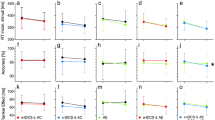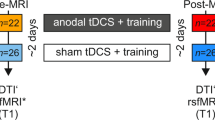Abstract
This is the first randomized, controlled study comparing the cognitive effects of transcranial laser stimulation and acute aerobic exercise on the same cognitive tasks. We examined whether transcranial infrared laser stimulation of the prefrontal cortex, acute high-intensity aerobic exercise, or the combination may enhance performance in sustained attention and working memory tasks. Sixty healthy young adults were randomly assigned to one of the following four treatments: (1) low-level laser therapy (LLLT) with infrared laser to two forehead sites while seated (total 8 min, 1064 nm continuous wave, 250 mW/cm2, 60 J/cm2 per site of 13.6 cm2); (2) acute exercise (EX) of high-intensity (total 20 min, with 10-min treadmill running at 85–90 % VO2max); (3) combined treatment (LLLT + EX); or (4) sham control (CON). Participants were tested for prefrontal measures of sustained attention with the psychomotor vigilance task (PVT) and working memory with the delayed match-to-sample task (DMS) before and after the treatments. As compared to CON, both LLLT and EX reduced reaction time in the PVT [F(1.56) = 4.134, p = 0.01, η 2 = 0.181] and increased the number of correct responses in the DMS [F(1.56) = 4.690, p = 0.005, η 2 = 0.201], demonstrating a significant enhancing effect of LLLT and EX on cognitive performance. LLLT + EX effects were similar but showed no significantly greater improvement on PVT and DMS than LLLT or EX alone. The transcranial infrared laser stimulation and acute aerobic exercise treatments were similarly effective for cognitive enhancement, suggesting that they augment prefrontal cognitive functions similarly.



Similar content being viewed by others
References
Castaneda AE, Tuulio-Henriksson A, Marttunen M, Suvisaari J, Lönnqvist J (2008) A review on cognitive impairments in depressive and anxiety disorders with a focus on young adults. J Affect Disord 106:1–27
Wong-Riley MT, Liang HL, Eells JT, Chance B, Henry MM, Buchmann E, Kane M, Whelan HT (2005) Photobiomodulation directly benefits primary neurons functionally inactivated by toxins: role of cytochrome c oxidase. J Biol Chem 280:4761–4771
Rojas JC, Gonzalez-Lima F (2011) Low-level light therapy of the eye and brain. Eye Brain 3:49–67
Rojas JC, Bruchey AK, Gonzalez-Lima F (2012) Low-level light therapy improves cortical metabolic capacity and memory retention. J Alzheimers Dis 32:741–752
Barrett DW, Gonzalez-Lima F (2013) Transcranial infrared laser stimulation produces beneficial cognitive and emotional effects in humans. Neuroscience 230:13–23
Yanagisawa H, Dan I, Tsuzuki D, Kato M, Okamoto M, Kyutoku Y, Soya H (2010) Acute moderate exercise elicits increased dorsolateral prefrontal activation and improves cognitive performance with Stroop test. Neuroimage 50:1702–1710
Coles K, Tomporowski PD (2008) Effects of acute exercise on executive processing, short-term and long-term memory. J Sports Sci 26:333–344
Pontifex MB, Hillman CH, Fernhall B, Thompson KM, Valentini TA (2009) The effect of acute aerobic and resistance exercise on working memory. Med Sci Sports Exerc 41:927–934
Sibley BA, Beilock SL (2007) Exercise and working memory: an individual differences investigation. J Sport Exerc Psychol 29:783–791
Ferris LT, Williams JS, Shen CL (2007) The effect of acute exercise on serum brain-derived neurotrophic factor levels and cognitive function. Med Sci Sports Exerc 39:728–734
Chang YK, Pesce C, Chiang YT, Kuo CY, Fong DY (2015) Antecedent acute cycling exercise affects attention control: an ERP study using attention network test. Front Hum Neurosci 9:156
Tian F, Hase SN, Gonzalez-Lima F, Liu H (2016) Transcranial laser stimulation improves human cerebral oxygenation. Lasers Surg Med. doi:10.1002/lsm.22471
Picard M, McEwen BS (2014) Mitochondria impact brain function and cognition. Proc Natl Acad Sci U S A 111:7–8
Ide K, Secher NH (2000) Cerebral blood flow and metabolism during exercise. Prog Neurobiol 61:397–414
Ando S, Hatamoto Y, Sudo M, Kiyonaga A, Tanaka H, Higaki Y (2013) The effects of exercise under hypoxia on cognitive function. PLoS One 8, e63630
Gligoroska JP, Manchevska S (2012) The effect of physical activity on cognition—physiological mechanisms. Mater Sociomed 24:198–202
Naeser MA, Zafonte R, Krengel MH, Martin PI, Frazier J, Hamblin MR, Knight JA, Meehan WP 3rd, Baker EH (2014) Significant improvements in cognitive performance post-transcranial, red/near-infrared light-emitting diode treatments in chronic, mild traumatic brain injury: open-protocol study. J Neurotrauma 31:1008–1017
Hashmi JT, Huang YY, Osmani BZ, Sharma SK, Naeser MA, Hamblin MR (2010) Role of low-level laser therapy in neurorehabilitation. PM&R 2:S292–S305
Gonzalez-Lima F, Barksdale BR, Rojas JC (2014) Mitochondrial respiration as a target for neuroprotection and cognitive enhancement. Biochem Pharmacol 88:584–593
Griffin ÉW, Mullally S, Foley C, Warmington SA, O’Mara SM, Kelly AM (2011) Aerobic exercise improves hippocampal function and increases BDNF in the serum of young adult males. Physiol Behav 104:934–941
Xuan W, Agrawal T, Huang L, Gupta GK, Hamblin MR (2015) Low-level laser therapy for traumatic brain injury in mice increases brain derived neurotrophic factor (BDNF) and synaptogenesis. J Biophotonics 8:502–511
Li L, Men WW, Chang YK, Fan MX, Ji L, Wei GX (2014) Acute aerobic exercise increases cortical activity during working memory: a functional MRI study in female college students. PLoS One 9, e99222
Dinges D, Powell J (1985) Microcomputer analyses of performance on portable, simple visual RT task during sustained operations. Behav Res Methods Instrum 17:652–655
Drummond SP, Bischoff-Grethe A, Dinges DF, Ayalon L, Mednick SC, Meloy MJ (2005) The neural basis of the psychomotor vigilance task. Sleep 28:1059–1068
Nieder A, Miller EK (2004) A parieto-frontal network for visual numerical information in the monkey. Proc Natl Acad Sci 101:7457–7462
Scott JP, McNaughton LR, Polman RC (2006) Effects of sleep deprivation and exercise on cognitive, motor performance and mood. Physiol Behav 87:396–408
Basner M, Mollicone D, Dinges DF (2011) Validity and sensitivity of a brief psychomotor vigilance test (PVT-B) to total and partial sleep deprivation. Acta Astronaut 69:949–959
Lara T, Madrid JA, Correa Á (2014) The vigilance decrement in executive function is attenuated when individual chronotypes perform at their optimal time of day. PLoS ONE 9, e88820
Miller LS, Lombardo TW, Fowler SC (1992) Time of day effects on a human force discrimination task. Physiol Behav 52:839–841
Howley ET, Bassett DR Jr, Welch HG (1995) Criteria for maximal oxygen uptake: review and commentary. Med Sci Sports Exerc 27:1292–1301
Kaufman AS, Kaufman NL (1990) Kaufman brief intelligence test. American Guidance Service, Circle Pnes, pp 1–9
Chudasama Y (2010) Delayed (non)match-to-sample task. Encyclopedia of Psychopharmacology, I. Springer Berlin Heidelberg, p 372–372
Mueller ST, Piper BJ (2014) The psychology experiment building language (PEBL) and PEBL test battery. J Neurosci Methods 222:250–259
Schiffer F, Johnston AL, Ravichandran C, Polcari A, Teicher MH, Webb RH, Hamblin MR (2009) Psychological benefits 2 and 4 weeks after a single treatment with near infrared light to the forehead: a pilot study of 10 patients with major depression and anxiety. Behav Brain Funct 5:46
Blanco NJ, Maddox WT, Gonzalez-Lima F (2015) Improving executive function using transcranial infrared laser stimulation. J Neuropsychol. doi:10.1111/jnp.12074
Garber CE, Blissmer B, Deschenes MR, Franklin BA, Lamonte MJ, Lee IM, Nieman DC, Swain DP (2011) American College of Sports Medicine position stand. Quantity and quality of exercise for developing and maintaining cardiorespiratory, musculoskeletal, and neuromotor fitness in apparently healthy adults: guidance for prescribing exercise. Med Sci Sports Exerc 43:1334–1359
Craik FI, Bialystok E (2006) Cognition through the lifespan: mechanisms of change. Trends Cogn Sci 10:131–138
Lawrence NS, Ross TJ, Hoffmann R, Garavan H, Stein EA (2003) Multiple neuronal networks mediate sustained attention. J Cogn Neurosci 15:1028–1038
Gonzalez-Lima F, Barrett D (2014) Augmentation of cognitive brain functions with transcranial lasers. Front Syst Neurosci 8:36
Maguire EA, Frith CD, Morris RG (1999) The functional neuroanatomy of comprehension and memory: the importance of prior knowledge. Brain 122:1839–1850
Yerkes RM, Dodson JD (1908) The relation of strength of stimulus to rapidity of habit-formation. J Comp Neurol Psychol 18:459–482
Martins AQ, Kavussanu M, Willoughby A, Ring C (2013) Moderate intensity exercise facilitates working memory. Psychol Sport Exerc 14:323–328
Ogoh S, Tsukamoto H, Hirasawa A, Hasegawa H, Hirose N, Hashimoto T (2014) The effect of changes in cerebral blood flow on cognitive function during exercise. Physiol Rep 2, e12163
Ogoh S, Ainslie PN (2009) Cerebral blood flow during exercise: mechanisms of regulation. J Appl Physiol 107:1370–1380
Kamijo K, Nishihira Y, Hatta A, Kaneda T, Kida T, Higashiura T, Kuroiwa K (2004) Changes in arousal level by differential exercise intensity. Clin Neurophysiol 115:2693–2698
Shansky RM, Lipps J (2013) Stress-induced cognitive dysfunction: hormone-neurotransmitter interactions in the prefrontal cortex. Front Hum Neurosci 7:123
Acknowledgments
The authors thank the Kinetic kidz laboratory members including Yen T. Chen, Jihoon Kim, Yeonhak Jung, Jeremy Setty, Hannah G. Calvert, and Elizabeth M. Glowacki for their help with data collection. The authors would also like to thank Dr. Douglas Barrett for their support with the cognitive tasks and Dr. R. Matthew Brothers and Dr. John L. Ivy for their support of our research. JH did this study in partial fulfillment of the requirements for a Ph.D. degree at The University of Texas at Austin. Research reported in this publication was supported by FGL from an institutional research fellowship from the College of Liberals Arts of the University of Texas at Austin. FGL holds the endowed George I. Sanchez Centennial Professorship in Liberal Arts and Sciences.
Author information
Authors and Affiliations
Corresponding author
Ethics declarations
Conflict of interest
The authors declare no competing financial interests.
Rights and permissions
About this article
Cite this article
Hwang, J., Castelli, D.M. & Gonzalez-Lima, F. Cognitive enhancement by transcranial laser stimulation and acute aerobic exercise. Lasers Med Sci 31, 1151–1160 (2016). https://doi.org/10.1007/s10103-016-1962-3
Received:
Accepted:
Published:
Issue Date:
DOI: https://doi.org/10.1007/s10103-016-1962-3




